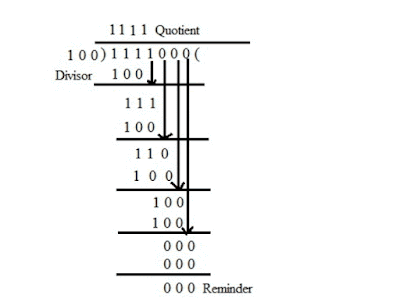Binary Division Rules
1 ÷ 1 = 1
1 ÷ 0 = Undefined
0 ÷ 1 = 0
0 ÷ 0 = Undefined
Steps to Solve:
The division process is performed like decimal division. The rules for binary division are:
◆ Start from the left of the dividend.
◆ Perform a series of subtraction in which the divisor is subtracted from the dividend.
◆If subtraction is possible, put a 1 in the quotient and subtract the divisor from the corresponding digits of the dividend.
◆ If subtraction is not possible (the divisor is greater than the remainder), record a 0 in the quotient.
◆ Bring down the next digit to add to the remaining digits. Proceed as before like long division.
Example: Divide 100001 by 110.
Step 5: Divisor greater, so put 0 in the quotient.
Example: Divide (1111000)₂ by (100)₂.
Key Notes Regarding Binary Division
Some of the crucial points to keep in mind about the process of binary division are:
1- Binary division involves the application of two other arithmetic operations - multiplication and subtraction.
2- To perform a binary division, a student is expected to follow the same procedure with which we divide regular numbers. The only difference is, in the case of binary division, we need to decide if it's 1 or 0 as a placeholder in the quotient, This makes calculation very easy.
3- Mathematical problems in binary division are simplified with the help of the long division method, which is easy and one of the most efficient ways to solve binary division.
Today, this method finds its application in the field of computer technology.
Important Point: Binary division is a process also known as the long division method, It is used to find the resultant easily. Hence it is used in place of other division methods (e.g. double division method)







